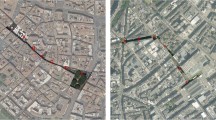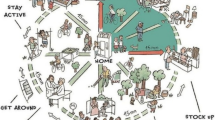Abstract
Traditionally, spaces have been classified as being located either indoors or outdoors. On closer inspection, however, this distinction is not as clear cut as usually assumed. For example, when navigating complex urban landscapes, pedestrians frequently traverse tunnels, enclosed footbridges or partially roofed courtyards. In this paper, we investigate this type of spaces between indoor and outdoor areas. We present an initial definition of transitional spaces based on a conceptual analysis, and then report on results from an empirical study with 103 pedestrians, whom we interviewed in an urban area. A statistical and linguistic analysis of the outcomes of the study provides evidence for the existence of transitional spaces and their use. The outcomes also support an initial set of characteristics and properties that further clarify these areas. The results pave the way for the further investigation of transitional spaces, e.g. in terms of providing effective navigation support through them.
Access this chapter
Tax calculation will be finalised at checkout
Purchases are for personal use only
Preview
Unable to display preview. Download preview PDF.
Similar content being viewed by others
References
Anthony, L.: AntConc 3.2.2.1 (Computer Software). Waseda University, Tokyo (2011), http://www.antlab.sci.waseda.ac.jp
Baus, J., Kray, C., Cheverst, K.: A Survey of Map-based Mobile Guides. In: Meng, L., Zipf, A., Reichenbacher, T. (eds.) Map-based Mobile Services, pp. 197–216. Springer, Heidelberg (2005)
Butz, A., Baus, J., Krüger, A., Lohse, M.: A Hybrid Indoor Navigation System. In: Proceedings of IUI 2001, pp. 25–32. ACM Press (2001)
Cheewinsiriwat, P.: Development of a 3D geospatial data representation and spatial analysis system. PhD dissertation, University of Newcastle Upon Tyne, UK (2009)
Cheverst, K., Davies, N., Friday, A., Efstratiou, C.: Developing a Context-aware Electronic Tourist Guide: Some Issues and Experiences. In: Proceedings. of CHI 2000, pp. 17–24. ACM Press (2000)
Döllner, J., et al.: Smart Buildings – a concept for ad-hoc creation and refinement of 3D building models. In: Proceedings of the 1st Int. Workshop on Next Generation 3D City Models, Bonn, Germany (2005)
Downs, R.M., Stea, D.: Maps in minds.: Reflections on cognitive mapping. Harper & Row (1977)
Fontaine, S., Denis, M.: The production of route instructions in underground and urban environments. In: Freksa, C., Mark, D.M. (eds.) COSIT 1999. LNCS, vol. 1661, pp. 83–94. Springer, Heidelberg (1999)
Fund, U. N. P. UNFPA state of world population: unleashing the potential of urban growth. (United Nations Population Fund, 2007) (2007)
Gröger, G., Kolbe, T.H., Nagel, C., Häftele, K.-H.: OGC City Geography Markup Language (CityGML) Encoding Standard. Discussion Paper, OGC Doc. No. 12-019 (2012)
Hölscher, C., Meilinger, T., Vrachliotis, G., Brösamle, M., Knauff, M.: Up the down staircase: Wayfinding strategies in multi-level buildings. Journal of Environmental Psychology 26, 284–299 (2006)
Hölscher, C., Büchner, S.J., Meilinger, T., Strube, G.: Adaptivity of wayfinding strategies in a multi-building ensemble: The effects of spatial structure, task requirements, and metric information. Journal of Environmental Psychology 29(2), 208–219 (2009)
Hölscher, C., Tenbrink, T., Wiener, J.M.: Would you follow your own route description? Cognitive strategies in urban route planning. Cognition 121(2), 228–247 (2011)
Isikdag, U., Aouad, G., Underwood, J., Trodd, G.: Representing 3D building elements using spatial data structures. In: Proceedings of Computers in Urban Planning and Urban Management (CUPUM), London, UK (2005)
Kray, C., Kortuem, G., Krüger, A.: Adaptive Navigation Support with Public Displays. In: Proceedings of IUI 2005, pp. 326–328 (2005)
Krüger, A., Butz, A., Müller, C., Stahl, C., Wasinger, R., Steinberg, K.-E., Dirschl, A.: The Connected User Interface: Realizing a Personal Situated Navigation Service. In: Proceedings of IUI 2004, pp. 161–168 (2004)
Landau, B., Jackendoff, R.: “What” and “Where” in spatial language and spatial cognition. Behavioral and Brain Sciences 16(2), 217–265 (1993)
Lewis, R., Séquin, C.: Generation of 3D Building Models from 2D Architectural Plans. Computer Aided Design 30(10), 765–780 (1998)
Link, J., Smith, P., Viol, N., Wehrle, K.: Footpath: Accurate map-based indoor navigation using smartphones. In: International Conference on Indoor Positioning and Indoor Navigation (IPIN), pp. 1–8. IEEE (2011)
Lynch, K.: The image of the city. MIT Press (1960)
Meijers, M., Zlatanova, S., Pfeifer, N.: 3D Geoinformation Indoors: Structuring for Evacuation. In: Proceedings of Next Generation 3D City Models, Bonn, Germany (2005)
Montello, D.: Scale and multiple psychologies of space. In: Campari, I., Frank, A.U. (eds.) COSIT 1993. LNCS, vol. 716, pp. 312–321. Springer, Heidelberg (1993)
Oppermann, R., Specht, M.: A Nomadic Information System for Adaptive Exhibition Guidance. In: International Cultural Heritage Meeting (ICHIM 1999), Washington D.C, pp. 103–109 (1999)
Slingsby, A.D., Longley, P.A.: A Conceptual Framework for Describing Microscale Pedestrian Access in the Built Environment. In: Proceedings of GISRUK, Nottingham, UK (2006)
Steck, S.D., Mallot, H.A.: The role of global and local landmarks in virtual environment navigation. Presence: Teleoper. Virtual Environ. 9, 69–83 (2000)
Author information
Authors and Affiliations
Editor information
Editors and Affiliations
Rights and permissions
Copyright information
© 2013 Springer International Publishing Switzerland
About this paper
Cite this paper
Kray, C., Fritze, H., Fechner, T., Schwering, A., Li, R., Anacta, V.J. (2013). Transitional Spaces: Between Indoor and Outdoor Spaces. In: Tenbrink, T., Stell, J., Galton, A., Wood, Z. (eds) Spatial Information Theory. COSIT 2013. Lecture Notes in Computer Science, vol 8116. Springer, Cham. https://doi.org/10.1007/978-3-319-01790-7_2
Download citation
DOI: https://doi.org/10.1007/978-3-319-01790-7_2
Publisher Name: Springer, Cham
Print ISBN: 978-3-319-01789-1
Online ISBN: 978-3-319-01790-7
eBook Packages: Computer ScienceComputer Science (R0)




